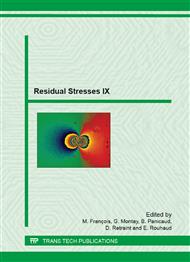[1]
H. Attia, S. Tavakoli, R. Vargas and V. Thomson, Laser-assisted high-speed finish turning of superalloy Inconel718 under dry conditions, CIRP Ann. Manuf. Technol. 59 (2010) 83–88.
DOI: 10.1016/j.cirp.2010.03.093
Google Scholar
[2]
S. Rajagopal, D.J. Plankenhorn and V.L. Hill, Machining aerospace alloys with the aid of 15 kW laser, J. of App. Metalworking, 2-3 (1982) 170-184.
DOI: 10.1007/bf02834035
Google Scholar
[3]
P. Dumitrescu, P. Koshy, J. Stenekes and M.A. Elbestawi, High-power diode laser assisted hard turning of AISI D2 tool steel, Int. J. Mach. Tool Manu. 46 (2006) 2009-(2016).
DOI: 10.1016/j.ijmachtools.2006.01.005
Google Scholar
[4]
S. Sun, M. Brandt and M.S. Dargusch, Thermally enhanced machining of hard-to-machine materials - A review, Int. J. Mach. Tool Manu. 50 (2010) 663-680.
DOI: 10.1016/j.ijmachtools.2010.04.008
Google Scholar
[5]
H. Ding and Y. C. Shin, Laser-assisted machining of hardened steel parts with surface integrity analysis, Int. J. Mach. Tool Manu. 50 (2010) 106-114.
DOI: 10.1016/j.ijmachtools.2009.09.001
Google Scholar
[6]
J. Kenda, F. Pusavec and J. Kopac, Analysis of residual stresses in sustainable cryogenic machining of nickel based alloy - Inconel 718, J. Eng. Mater. Tech. 133 (2011) 1-7.
DOI: 10.1115/1.4004610
Google Scholar
[7]
G. Germain, P. DalSanto and J.L. Lebrun, Comprehension of chip formation in laser assisted machining, Int. J. Mach. Tool Manu. 51 (2011) 230-238.
Google Scholar
[8]
V. Navas, I. Arriola, O. Gonzalo and J. Leunda, Mechanisms involved in the improvement of Inconel 718 machinability by laser assisted machining, Int. J. Mach. Tool Manu. 74 (2013) 19-28.
DOI: 10.1016/j.ijmachtools.2013.06.009
Google Scholar
[9]
M. Anderson, R. Patwa and Y.C. Shin, Laser-assisted machining of Inconel 718 with an economic analysis, Int. J. Mach. Tool Manu. 46 (2006) 1879-1891.
DOI: 10.1016/j.ijmachtools.2005.11.005
Google Scholar
[10]
T. B. Bouchnak, G. Germain, A. Morel and J.L. Lebrun, Influence of laser assistance on the machinability of the titanium alloy Ti555-3, Int. J. Adv. Manuf. Technol. 68 (2013) 2471-2481.
DOI: 10.1007/s00170-013-4855-7
Google Scholar
[11]
B. Shi, H. Attia, R. Vargas and S. Tavakoli, Numerical and experimental investigation of laser-assisted machining of Inconel 718, Mach. Sci. Technol. 12 (2008) 498-513.
DOI: 10.1080/10910340802523314
Google Scholar
[12]
M.N.A. Nasr, E-G. Ng and M.A. Elbestawi, A modified time-efficient FE approach for predicting machining-induced residual stresses, Finite Elem. Anal. Des. 44 (2008) 149-161.
DOI: 10.1016/j.finel.2007.11.005
Google Scholar
[13]
M.N.A. Nasr, E-G. Ng and M.A. Elbestawi, Effects of strain hardening & initial yield strength on machining-induced residual stresses, J. Eng. Mater. Tech. 129 (2007) 567-579.
DOI: 10.1115/1.2772338
Google Scholar
[14]
T. Mabrouki, J-F. Rigal, A contribution to a qualitative understanding of thermo-mechanical effects during chip formation in hard turning, J. Mater. Process. Technol. 176 (2006) 214-221.
DOI: 10.1016/j.jmatprotec.2006.03.159
Google Scholar
[15]
M.N.A. Nasr, E-G. Ng and M.A. Elbestawi, Effects of workpiece thermal properties on machining-induced residual stresses – thermal softening and conductivity, Proc. Inst. Mech. Eng., B J. Eng. Manuf. 221 (2007) 1387-1400.
DOI: 10.1243/09544054jem856
Google Scholar
[16]
C.R. Liu and Y.B. Guo, Finite Element Analysis of the Effect of Sequential Cuts and Tool-Chip Friction on Residual Stresses in a Machined Layer", Int. J. Mech. Sc. 42 (2000) 1069-1086.
DOI: 10.1016/s0020-7403(99)00042-9
Google Scholar
[17]
H. Schmidt and J. Hattel, A Local Model for the Thermomechanical Conditions in Friction Stir Welding", Modell. Simul. Mater. Sci. Eng. 13 - 1 (2005) 77-93.
DOI: 10.1088/0965-0393/13/1/006
Google Scholar
[18]
C. Shet and X. Deng, Residual Stresses and Strains in Orthogonal Metal Cutting, Int. J. Mach. Tool Manu. 43 (2003) 573-587.
DOI: 10.1016/s0890-6955(03)00018-x
Google Scholar
[19]
T. I El-Wardany, H.A. Kishawy and M.A. Elbestawi, Surface Integrity of Die Materials in High Speed Hard Machining. Part 2: Micro-hardness Variations and Residual Stresses, J. Eng. Mater. Tech. 122 - 4 (2000) 632-641.
DOI: 10.1115/1.1286557
Google Scholar


